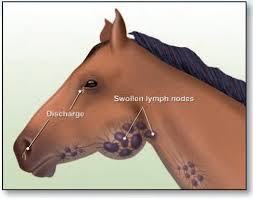Strangles A Disease That All Horse Owners Dread
What is Strangles?
 Strangles, named after the effect it has on the throat, is an upper respiratory tract infection of horses, ponies and donkeys of any age, sex or breed. Caused by the bacterium Streptococcus equi equi, it is prevalent in domesticated horses worldwide, and one of the most common equine diseases in the UK. It is a highly contagious and easily transmitted disease, making quick diagnosis and effective treatment paramount.
Strangles, named after the effect it has on the throat, is an upper respiratory tract infection of horses, ponies and donkeys of any age, sex or breed. Caused by the bacterium Streptococcus equi equi, it is prevalent in domesticated horses worldwide, and one of the most common equine diseases in the UK. It is a highly contagious and easily transmitted disease, making quick diagnosis and effective treatment paramount.
What are the signs and symptoms of Strangles?
The disease causes abscesses in the lymph nodes of the head, neck and throat of horses and other equine animals, which in turn put pressure on the windpipe and cause difficulties in breathing and swallowing. High fever and loss of appetite are common signs that a horse may be infected, along with snotty nasal discharge. Sometimes a horse will also experience the swelling of limbs, underbelly and sheath.
If you are concerned about your horse(s) or suspect they may have caught the disease swift action of will give them the best chances of recovery. Immediately isolate the horse to prevent further spread and seek the help of a vet.
How is Strangles diagnosed?

Diagram from Brown Moss Equine Clinic
There are three main diagnostic tools when a horse is suspected of Strangles: swabs, endoscopes and blood tests. A swab of a draining abscess, the naval capacity or the back of the throat can be tested for the bacterium that causes the disease. An endoscope (a long fibre optic camera) can be inserted into the back of the throat to show any chondroids or pus in the guttural pouches. A blood sample can be taken and tested for the antibodies to the bacterium that causes the disease, which in turn suggests the recent presence of the disease in the horse.
How is Strangles treated?
Nursing care and anti-inflammatory medication are the main forms of treatment for a sufferer of Strangles, along with the cleaning and disinfecting of burst abscesses. Antibiotics are usually not necessary, but each case should be judged on an individual basis, and medical advice sought from a professional.
How does Strangles spread?
The infection is spread between equine animals through the nasal discharge or pus from a draining lymph node of an infected horse. This can happen directly – through nose-to-nose contact of horses; and indirectly – through contact with infected discharge on clothes, shoes, yard utensils and water troughs.
How to prevent the spread of Strangles

Symptoms image from Thesprucepets.com
As already mentioned, Strangles is an extremely contagious disease and one that can, in certain cases, be fatal. Isolation of infected horses is the first way to prevent it from spreading to other horses, encompassing the utensils, clothes and airspace used and touched by the horse. If an outbreak occurs at your yard it should be closed to new arrivals, and onsite horses kept there as not to move the disease to other places.
Basic hygiene is pivotal in reducing the risk of spread – from the washing of hands to the disinfecting of clothes used when in contact with infected animals.
Seemingly healthy horses who have come into contact with infected horses should be closely monitored for signs of Strangles, as, even without obvious symptoms, they may be carriers of the disease and may retain the infection within small pouches in their throat.
Recovered horses should not be reintroduced to the shared areas of the yard until demonstrated by a vet to no longer be contagious.
Please note that we are not Vets and this article has been created as an informative article to help horse owners be aware of the strangles disease. If you have any concerns about your horse’s health you should seek an equine vet immediately.






